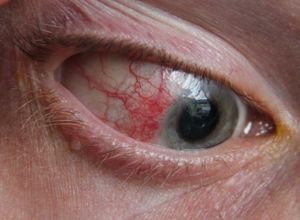We need you! Join our contributor community and become a WikEM editor through our open and transparent promotion process.
Episcleritis
From WikEM
Contents
Background
- Abrupt onset of inflammation in the episclera
- 70% of cases occurs in women (usually young/middle-aged)
- Usually a benign, self-limited condition
- Can be classified into simple (more common) or nodular types
- Most commonly idiopathic but may occur as an ocular manifestation of underlying autoimmune conditions eg RA, IBD
Clinical Features
History
- Abrupt onset of redness, irritation, and watering of the eye
- Pain is unusual
- Vision unaffected
- 50% of cases are bilateral
Physical exam
- Vasodilatation of the superficial episcleral vessels
- Focal area(s) of redness
- May have a tender scleral nodule (nodular episcleritis)
Differential Diagnosis
Unilateral Red Eye
- Acute angle-closure glaucoma^
- Anterior uveitis
- Caustic keratoconjunctivitis^^
- Conjunctival laceration
- Conjunctivitis
- Corneal abrasion
- Corneal erosion
- Ocular foreign body
- Corneal ulcer^
- Endophthalmitis^
- Episcleritis
- Globe rupture^
- Herpes zoster ophthalmicus
- Intraocular foreign body
- Inflamed pingueculum
- Inflamed Pterygium
- Keratoconjunctivitis
- Keratoconus
- Lens dislocation
- Nontraumatic iritis
- Scleritis^
- Subconjunctival hemorrhage
- Traumatic hyphema
- Traumatic iritis
- Ultraviolet keratitis
^Emergent diagnoses
^^Critical diagnoses
Evaluation
- Must distinguish from scleritis
- Scleritis likely to have pain and decreased vision
- Use of 2.5% phenylephrine drops will cause vasoconstriction/blanching of episcleral but not scleral vessels. Thus, there will be decreased injection and redness in episcleritis but not scleritis.[1]
- Red area will be mobile if moved with a moist q-tip
- Must distinguish from conjunctivitis
- Episcleritis will usually have a sectoral pattern of injection, as opposed to a diffuse injection seen in conjunctivitis.
Management
- Topical lubricants
- Artificial tears q4-6hr
- Oral NSAIDs
Disposition
- Refer to ophtho is unsure of diagnosis or if steroids are necessary for treatment
- Self-limiting (will resolve within 2-3 weeks)
See Also
External Links
References
- ↑ Mahmood AR, Narang AT. Diagnosis and management of the acute red eye. Emerg Med Clin North Am 2008; 26:35-55.

